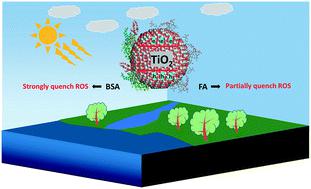当前位置:
X-MOL 学术
›
Environ. Sci.: Nano
›
论文详情
Our official English website, www.x-mol.net, welcomes your
feedback! (Note: you will need to create a separate account there.)
Impact of surface adsorbed biologically and environmentally relevant coatings on TiO2 nanoparticle reactivity
Environmental Science: Nano ( IF 5.8 ) Pub Date : 2020-10-15 , DOI: 10.1039/d0en00706d Haibin Wu 1, 2, 3, 4 , Liubin Huang 1, 2, 3, 4 , Amber Rose 1, 2, 3, 4 , Vicki H. Grassian 1, 2, 3, 4, 5
Environmental Science: Nano ( IF 5.8 ) Pub Date : 2020-10-15 , DOI: 10.1039/d0en00706d Haibin Wu 1, 2, 3, 4 , Liubin Huang 1, 2, 3, 4 , Amber Rose 1, 2, 3, 4 , Vicki H. Grassian 1, 2, 3, 4, 5
Affiliation

|
Studies have shown that environmentally and biologically relevant coatings on nanoparticle (NP) surfaces can significantly alter the physicochemical properties (e.g. dissolution and aggregation) of particles yet there remain some questions on how these coatings impact reactivity. In this study, we investigated molecular-level details of surface adsorption and surface reactivity of titanium dioxide (TiO2) NPs using in situ attenuated total reflectance-Fourier transform infrared spectroscopy (ATR-FTIR) in the presence of bovine serum albumin (BSA) protein and fulvic acid (FA), which were selected as representative biologically and environmentally relevant molecules. Our results show that both BSA and FA adsorb strongly and irreversibly onto TiO2 NP surfaces at neutral pH and these surface coatings impact the photochemical behavior of TiO2. In particular, we show large differences in the formation of reactive oxygen species (ROS) for coated compared to uncoated TiO2 NPs, as well as differences between the two different coatings. In the absence of any coatings, the photooxidation of solution phase sodium benzoate (BA) to hydroxyl benzoate (major product) is observed. However, this reaction is completely inhibited when TiO2 is coated with BSA and partially inhibited when TiO2 is coated with FA. Additionally, we found that BSA can strongly scavenge ROS generated upon irradiation by quenching the formation of electron–hole pairs. In contrast, the behavior of FA shows photoinduced hydrophilicity of the TiO2 coated surface and the generation of ROS, although less than that of the uncoated TiO2 NPs. Overall, these results show that the formation of ROS from TiO2 NPs coated by BSA and FA is reduced. Overall, this study provides insights into the impacts of environmentally and biologically relevant coatings and how they may modify the reactivity of the NPs in the environment. Furthermore, the implications of this study extend to understanding the potential reduced toxicity and impacts of TiO2 NPs with coatings in natural and human-impacted ecosystems.
中文翻译:

表面吸附的生物和环境相关涂层对TiO2纳米颗粒反应性的影响
研究表明,纳米颗粒(NP)表面上与环境和生物学相关的涂层可以显着改变颗粒的物理化学性质(例如,溶解和聚集),但是对于这些涂层如何影响反应性仍然存在一些疑问。在这项研究中,我们研究了在牛血清白蛋白(BSA)存在下使用原位衰减全反射-傅里叶变换红外光谱(ATR-FTIR)研究二氧化钛(TiO 2)NPs的表面吸附和表面反应性的分子水平细节。蛋白质和富里酸(FA),被选为具有代表性的生物学和环境相关分子。我们的结果表明,BSA和FA均强烈且不可逆地吸附到TiO 2上在中性pH下的NP表面和这些表面涂层会影响TiO 2的光化学行为。特别是,与未涂层的TiO 2 NP相比,涂层的活性氧(ROS)的形成存在很大差异,并且两种涂层之间也存在差异。在不存在任何涂层的情况下,观察到溶液相苯甲酸钠(BA)被光氧化为苯甲酸羟基酯(主要产物)。然而,当二氧化钛该反应完全抑制2涂覆有BSA和部分抑制时的TiO 2涂有FA。此外,我们发现BSA可以通过淬灭电子-空穴对的形成来强力清除辐射产生的ROS。相反,FA的行为显示了TiO 2涂覆表面的光诱导亲水性和ROS的产生,尽管比未涂覆的TiO 2 NPs少。总体而言,这些结果表明,由BSA和FA包覆的TiO 2 NPs形成ROS减少了。总的来说,这项研究提供了对与环境和生物学相关的涂层的影响以及它们如何改变环境中NPs反应性的见解。此外,这项研究的意义扩展到理解TiO 2潜在的降低的毒性和影响 在自然和人类影响的生态系统中具有涂层的NP。
更新日期:2020-11-03
中文翻译:

表面吸附的生物和环境相关涂层对TiO2纳米颗粒反应性的影响
研究表明,纳米颗粒(NP)表面上与环境和生物学相关的涂层可以显着改变颗粒的物理化学性质(例如,溶解和聚集),但是对于这些涂层如何影响反应性仍然存在一些疑问。在这项研究中,我们研究了在牛血清白蛋白(BSA)存在下使用原位衰减全反射-傅里叶变换红外光谱(ATR-FTIR)研究二氧化钛(TiO 2)NPs的表面吸附和表面反应性的分子水平细节。蛋白质和富里酸(FA),被选为具有代表性的生物学和环境相关分子。我们的结果表明,BSA和FA均强烈且不可逆地吸附到TiO 2上在中性pH下的NP表面和这些表面涂层会影响TiO 2的光化学行为。特别是,与未涂层的TiO 2 NP相比,涂层的活性氧(ROS)的形成存在很大差异,并且两种涂层之间也存在差异。在不存在任何涂层的情况下,观察到溶液相苯甲酸钠(BA)被光氧化为苯甲酸羟基酯(主要产物)。然而,当二氧化钛该反应完全抑制2涂覆有BSA和部分抑制时的TiO 2涂有FA。此外,我们发现BSA可以通过淬灭电子-空穴对的形成来强力清除辐射产生的ROS。相反,FA的行为显示了TiO 2涂覆表面的光诱导亲水性和ROS的产生,尽管比未涂覆的TiO 2 NPs少。总体而言,这些结果表明,由BSA和FA包覆的TiO 2 NPs形成ROS减少了。总的来说,这项研究提供了对与环境和生物学相关的涂层的影响以及它们如何改变环境中NPs反应性的见解。此外,这项研究的意义扩展到理解TiO 2潜在的降低的毒性和影响 在自然和人类影响的生态系统中具有涂层的NP。











































 京公网安备 11010802027423号
京公网安备 11010802027423号